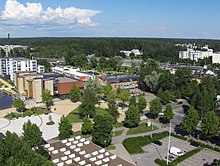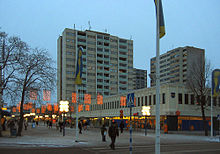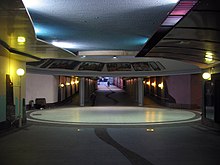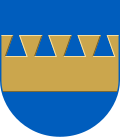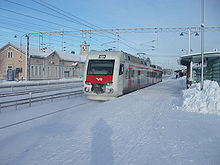Kerava
| coat of arms | map |
|---|---|

|
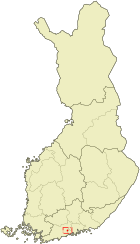
|
| Basic data | |
| State : |
|
| Landscape : | Uusimaa |
| Administrative community : | Helsinki |
| Geographical location | 60 ° 24 ' N , 25 ° 7' E |
| Surface: | 30.79 km² |
| of which land area: | 30.62 km² |
| of which inland waterways: | 0.17 km² |
| Residents : | 36,254 (Dec 31, 2018) |
| Population density : | 1,184 inhabitants / km² |
| Municipality number : | 245 |
| Postcodes : | 04200, 04201, 04220, 04230, 04250, 04251, 04260, 04261 |
| Language (s) : | Finnish |
| Website : | www.kerava.fi |
| Map of the city of Kerava | |
Kerava [ ˈkɛrɑvɑ ] ( Swedish. Kervo ) is a city in southern Finland with around 35,000 inhabitants. It is located a little north of the capital Helsinki and belongs to its metropolitan area . The population of the city has been rising steadily for years due to the influx from rural areas of Finland to the Helsinki region: Since 1980 the number of inhabitants has increased by over a third. Almost 96% of Kerava's residents speak Finnish as their mother tongue, only 1% are Finland-Swedes . This means that the city is officially monolingual in Finnish.
geography
Kerava is located around 27 km north of the Finnish capital Helsinki in the Uusimaa region . Neighboring communities are Tuusula in the west, Sipoo in the east and the city of Vantaa in the south. Kerava belongs to the Helsinki region and is closely connected to the capital.
With only 30.79 km² Kerava is the fifth smallest municipality in Finland, with a population density of over 1000 inhabitants per square kilometer, but also the most densely populated after Helsinki and Kauniainen . The municipality is traversed from north to south by the Keravanjoki River, over which several bridges run in the urban area. The river is also the city's only inland body of water; Kerava is one of the few Finnish municipalities without a lake.
history
The first humans reached the Kerava area after the end of the last ice age around 9000 years ago. At that time, the water level of Lake Ancylus , the forerunner of the Baltic Sea , was around 40 meters higher than it is today, so Kerava was on the coast. The Stone Age population lived from hunting and fishing.
The first sedentary settlement arose in Kerava in the Middle Ages, before the Hämeer had used the area as a hunting ground. In the Kerava area there were two villages, Alikerava and Ylikerava ("Upper" and "Lower Kerava"), which initially belonged to the parish of Sipoo . After the establishment of the Tuusula parish in 1643, Kerava became part of it. It is assumed that in the middle of the 16th century the population of Kerava was only around 160, even after that the area remained sparsely populated.
When the railway line to Helsinki was completed in 1862, Kerava had around 450 inhabitants. In the years that followed, the railway connection led to the settlement of businesses, especially those from the construction and woodworking industries, and growth in the city. Finland's first brick factory opened in what is now the Savio district in 1860, and the country's first cement factory in 1869. In 1913, the Nahkatehdas Oy Nahkimo leather factory followed , mainly producing boots for the Russian tsarist army . When sales collapsed after Finland gained independence, the factory went bankrupt in 1919; In 1925 , the Nokia concern set up a rubber factory in their property, the so-called “Klondyke House” ( Klondyke-talo ) .
In 1924 Kerava was released from the Tuusula community as an independent market town. At that time the place had around 3000 inhabitants and also included the area of Korso , which was attached to Vantaa in 1955 . In the 1960s and 1970s, Kerava's population almost doubled due to the rural exodus. Kerava has had town charter since 1970.
Cityscape and architectural monuments
Kerava is a very young and quite faceless satellite city . The compact city center is characterized by concrete and prefabricated buildings, the residential areas by modern terraced houses . Around 60% of the city's residents live in apartment buildings, another 14% in terraced houses, and only 25% in their own homes. The Heikkilä manor, a wooden building from the 18th century that is used today as a local museum and event location, creates a contrast in the cityscape.
The road Kauppakaari in the city center is expanded to 850 meters as a pedestrian, making it the longest pure pedestrian street in Finland. The pedestrian zone was created after the completion of a bypass road around the center from the previous main artery of Tuusulantie . Since 1993 the pedestrian street has been running under the railway line to the eastern part of Sampola. The entrance hall of the ambitiously designed underpass is adorned with a large-format painting by the artist Alpo Jaakkola.
The Lutheran parish church of Kerava was completed in 1965 according to plans by Ahti Korhonen; It was not until 1955 that Kerava was detached from the Tuusula parish as an independent parish. The church was built using modern concrete and brick and is typical of the functionalism of the 1960s with its clear, cubic design language, the lack of ornamentation and the strict geometry of the glass surfaces . Immediately opposite the church is the parish hall, which was also designed by Korhonen in 1969. The Kaleva and Savio districts have their own community centers.
In addition to the church and the Heikkilä manor, some industrial buildings in the Savio district, the town's train station and water tower built between 1876 and 1878, and the prison complex in the north of the town are listed as historical monuments. It was set up as a youth prison in 1891 and further buildings were added in the following decades. The current 170 inmates are mostly convicted in the first prison from the entire province of southern Finland, the focus is still on the rehabilitation of juvenile offenders.
There are numerous modern sculptures throughout the city, which the city markets as a "cultural tour". Particularly noteworthy is a life-size bronze statue of the obstacle runner and double Olympic champion Volmari Iso-Hollo , who at the time competed for the Keravan Urheilijat athletics club .
politics
City council
In Kerava, the conservative-liberal National Collection Party and the Social Democrats are equally strong. Since the election on April 9, 2017, the rallying party and the Social Democrats have each been represented with 13 out of a total of 51 seats in the city council, the highest decision-making body in local affairs. The third largest parliamentary group is the Green Bund with nine representatives. The left-wing alliance and the right-wing populist True Finns each have six seats. The Center Party , although it belongs to the three big parties across Finland, plays a rather subordinate role with three seats on the city council, as in general in the cities of southern Finland. The Christian Democrats are represented with one seat. The Swedish People's Party and the Pirate Party are not represented on the council due to the election result.
The term of office began on January 1, 2018 and ends on December 31, 2021.
| Political party | Election result 2017 | Seats |
|---|---|---|
| National rally party | 23.8% | 13 |
| Social democrats | 24.9% | 13 |
| Green covenant | 17.3% | 9 |
| Center Party | 5.6% | 3 |
| Left alliance | 12.2% | 6th |
| True Finns | 10.9% | 6th |
| Christian Democrats | 3.5% | 1 |
| Swedish People's Party | 1.3% | 0 |
| Pirate party | 0.5% | 0 |
The turnout in 2017 was 56.6 percent.
Kirsi Rontu has been the city director of Kerava since 2016.
coat of arms
The Kerava coat of arms was designed by the heraldist Ahti Hammar, who is also responsible for numerous other Finnish municipal coats of arms. It was put into use in 1956 and replaced the first municipal coat of arms designed by designer Ilmari Tapiovaara , which was official from 1949 to 1955.
Description of today's coat of arms : In the blue shield there is a golden bar on top with a broad inside cut (dovetail). This motif points to the traditionally great importance of the woodworking industry in Kerava.
Since 2002, the city has used the official coat of arms for advertising purposes as well as a modern logo in the form of a green zigzag line, supplemented by the name of the city.
Town twinning
Kerava lists ten twin cities :
| city | country |
|---|---|
| Arumeru |
|
| Aschersleben |
|
| Hjørring |
|
| Keila |
|
| Kristiansand |
|
| Ogre |
|
| Reykjanesbær |
|
| Solt |
|
| Trollhättan |
|
| Vladimir |
|
Economy and Infrastructure
Economic structure
Due to its proximity to Helsinki as a business location, Kerava is largely a commuter city. Of the approximately 16,000 working residents, only about a third work in Kerava. Another third is employed in the city of Helsinki. In Kerava itself there are around 10,000 jobs with a typical urban structure. Over 40% of jobs are in the service sector , mainly in commerce, tourism and finance. Almost 30% are employed in the public sector and almost 20% in industry. The largest private employer is the Sinebrychoff brewery with 870 employees (2005) , which has one of its two plants in Kerava. The unemployment rate in Kerava in 2006 was 4.9% below the national average.
traffic
In terms of transport, Kerava is well connected to nearby Helsinki. The Helsinki- Lahti motorway , part of State Road 4 ( E 75 ), passes east of the center of Kerava. The distance to Helsinki is around 30 km and to Helsinki-Vantaa Airport 20 km. The capital can be reached from Kerava in around 25 minutes by local rail transport in the Helsinki region . The section between Helsinki and Kerava has four tracks. At peak times, three express trains and six slower trains run every hour on the route. In addition to the main train station, there is a second train station, Savio, in the urban area of Kerava. There is also a railway line to Porvoo , but passenger traffic was stopped on this in 1981 and has been completely shut down since 1990.
Traditionally, Kerava places particular emphasis on creating good conditions for pedestrians and cyclists. In the municipality there are bike paths with a total length of 70 kilometers. Since 2001 the city has participated as one of three Finnish municipalities (together with Jyväskylä and Lempäälä ) in the model municipality project of the Finnish Ministry of Transport to develop concepts for pedestrian and bicycle traffic. The project aims in particular to improve overall transport solutions by closing gaps in the road, providing bicycle parking spaces at junctions, increasing safety for pedestrians and cyclists and offering combination tickets in local public transport.
Culture
Since Kerava is located in the catchment area of the capital, the residents of the city primarily use the cultural offerings of the Helsinki region. But also in Kerava itself, mostly supported by the city, a number of recurring cultural events are offered.
Since 1987 a garlic festival has been held every August in the pedestrian zone in Kerava . Kerava calls itself the "garlic city of Finland". The Kerava Jazz jazz festival, which has been held annually in June since 1991 , focuses on free jazz . In September the city center is populated for two days by the Sirkusmarkkinat festival . As part of the Helmimusiikki (“ Pearl Music ”) program, classical music concerts are held several times a year.
The city's art museum is housed in a former Nokia rubber factory , the so-called "Klondykehaus". The permanent and temporary exhibitions show mainly modern Finnish art.
education
Kerava has a wide range of day care centers. In addition to a number of municipal kindergartens, there are also various private ones. There are kindergartens with a focus on art, sport and languages (German, English, Russian, Swedish).
sons and daughters of the town
- Rakel Liehu (* 1939), writer
- Antti Soramies (* 1972), radio presenter
- Hanna-Maria Seppälä (* 1984), swimmer, world champion in the 100-meter freestyle in Barcelona 2003
- Alina Tomnikov (* 1988), actress
Web links
swell
- ↑ Maanmittauslaitos (Finnish land surveying office): Suomen pinta-alat kunnittain January 1, 2010 . (PDF; 199 kB)
- ↑ Statistical Office Finland: Table 11ra - Key figures on population by region, 1990-2018
- ↑ Website of the city: Historiaa (finn.) ( Memento of the original from February 19, 2007 in the Internet Archive ) Info: The archive link was inserted automatically and has not yet been checked. Please check the original and archive link according to the instructions and then remove this notice.
- ↑ a b Statistical Kerava 2006 (finn./engl.) ( Memento of the original on 28 September 2007 at the Internet Archive ) Info: The archive link is automatically inserted and not yet tested. Please check the original and archive link according to the instructions and then remove this notice. (PDF; 250 kB)
- ↑ Website of the city: Kauppakaari - Keravan kävelykeskusta (Finnish) ( Memento of the original from April 14, 2007 in the Internet Archive ) Info: The archive link has been inserted automatically and has not yet been checked. Please check the original and archive link according to the instructions and then remove this notice.
- ↑ Website of the city: Kulttuurikävely (Finnish) ( Memento of the original from April 15, 2007 in the Internet Archive ) Info: The archive link was inserted automatically and has not yet been checked. Please check the original and archive link according to the instructions and then remove this notice.
- ↑ Finnish Ministry of Justice: Result of the 2015 local elections - Kerava
- ↑ Website of the city: Keravan vaakuna (Finnish) ( Memento of the original from February 21, 2007 in the Internet Archive ) Info: The archive link was inserted automatically and has not yet been checked. Please check the original and archive link according to the instructions and then remove this notice.
- ↑ Ystävyyskunnat - Keravan Kaupunki . Retrieved May 29, 2017.
- ↑ Website of the city: Tilastotietoja Keravasta (Finnish) ( Memento of the original from February 19, 2007 in the Internet Archive ) Info: The archive link was inserted automatically and has not yet been checked. Please check the original and archive link according to the instructions and then remove this notice.
- ↑ Finnish Ministry of Transport: Kestävän liikenteen mallikuntahanke 2001–2004 ( Memento of the original from September 28, 2007 in the Internet Archive ) Info: The archive link was inserted automatically and has not yet been checked. Please check the original and archive link according to the instructions and then remove this notice.
- ↑ Website of the city: Kerava - Valkosipulikaupunki (Finnish) ( Memento of the original from February 21, 2007 in the Internet Archive ) Info: The archive link was inserted automatically and has not yet been checked. Please check the original and archive link according to the instructions and then remove this notice.
- ↑ Suomijazz.com: Kerava on free jazzin pyhättö (Finnish) ( Memento of the original from November 18, 2006 in the Internet Archive ) Info: The archive link was inserted automatically and has not yet been checked. Please check the original and archive link according to the instructions and then remove this notice.

